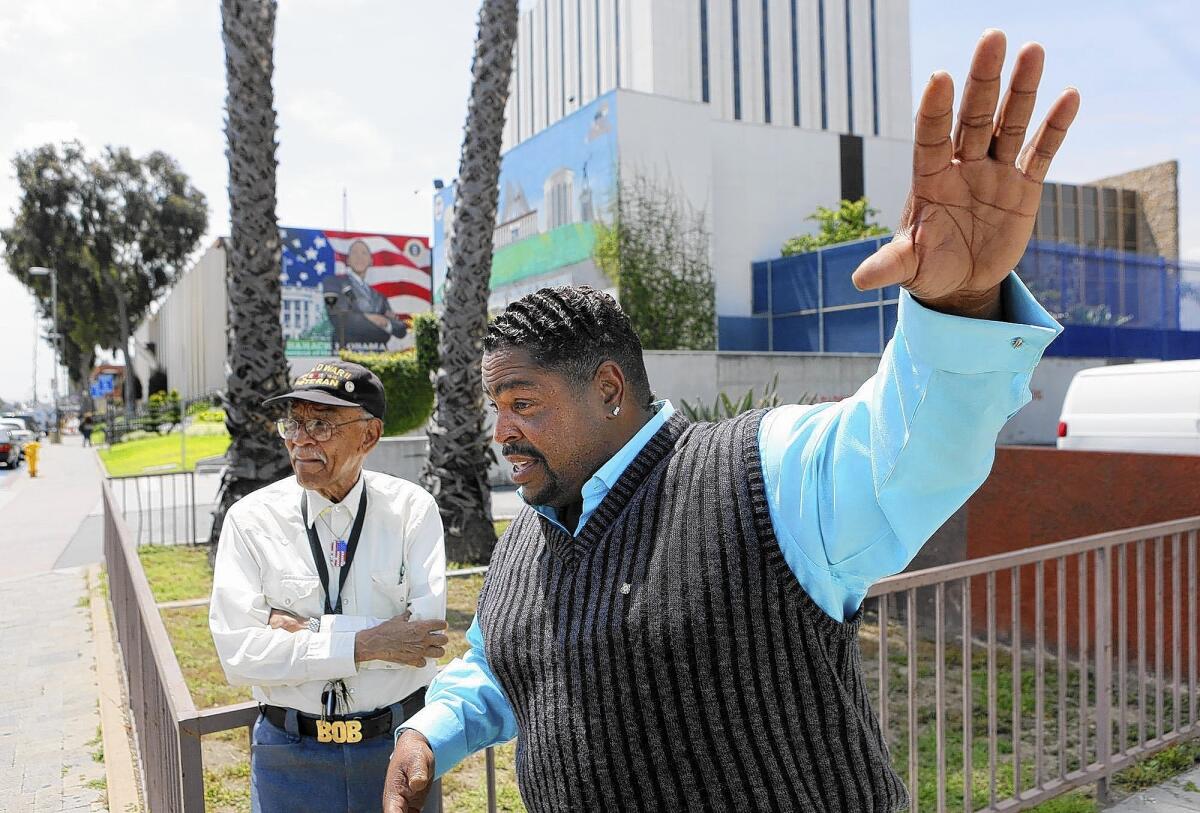L.A. County Sheriff’s Dept. used spy plane to watch Compton

To the 96,000 residents of Compton, the little Cessna would have looked like scores of other small planes that flew over the city each day.
But anyone paying close attention might have noticed the single-engine craft kept circling the city in a continuous loop. What they could not have known was that it packed unusual cargo — a bank of a dozen wide-angle industrial imaging cameras. They recorded low-resolution images of every corner of the 10.1-square-mile city.
For nine days in early 2012, the small plane beamed the images to the local Sheriff’s Department station, where deputies observed fender benders, necklace snatchings and a shooting.
MAPPING L.A.: Crime in Compton
The test was part of a larger effort by the Sheriff’s Department to use aerial surveillance for crime-fighting in the sprawling collection of communities it patrols. Around the same time, the sheriff was launching a similar aircraft observation program 80 miles north in the desert city of Lancaster.
But while Lancaster’s effort was publicized and debated at City Council meetings, the Sheriff’s Department didn’t notify either Compton residents or elected leaders about the test in that city.
And that has left some bad feelings in Compton.
“There is nothing worse than believing you are being observed by a third party unnecessarily,” Compton Mayor Aja Brown said Wednesday. “We want to assure the peace of mind of our citizens.”
After learning this week of the surveillance pilot program, Brown proposed a “citizen privacy protection policy,” to require public notification the next time authorities deploy monitoring equipment.
Revelations about the video monitoring of Compton provoked complaints by civil libertarians as well as doubts from a technologist about whether the video images were intrusive enough to truly thwart crime.
The discussion comes at a time of increasing debate about the powers and pitfalls of techno-surveillance, which can be used to observe citizens from afar, to identify individuals based on their unique facial characteristics and to keep samples of a citizen’s unique biology via their DNA.
The Compton surveillance program had gone mostly unknown until the Center for Investigative Reporting, a Berkeley-based journalism nonprofit, reported earlier this month that the Los Angeles County Sheriff’s Department had used the high-powered cameras to watch over Compton. The city contracts with the Los Angeles Sheriff’s Department for police services.
Sheriff’s officials flirted with the surveillance after being approached by a representative of Persistent Surveillance Systems, a Dayton, Ohio-based firm that supplies planes and cameras to law enforcement agencies.
Company President Ross T. McNutt said he met with officials from both the sheriff’s Compton station and headquarters to try to sell them on his Hawkeye II system, which he said provided sweeping images equivalent to what would come from 800 video cameras.
McNutt said the company’s Cessna flew at 10,000 feet in a loop about four miles wide, with the cameras storing images from around the city, while beaming them to the sheriff’s Compton office and air headquarters in Long Beach. Only images tied to known crime scenes received close scrutiny, McNutt said.
“We start from reported crime scenes. That is the only way we get involved,” McNutt said. “So, if there is a home invasion robbery or a homicide, we look for people who are fleeing. Often, we can catch up to them in real time. We can find a house they fled to or a house they came from in the first place.”
The cameras, despite a total 192 million pixels of resolution, sweep such a wide area that each individual appears as a single pixel — not nearly discerning enough to detect race, sex or other distinguishing characteristics, McNutt said. Those attributes and the focus only on known crime scenes should alleviate concerns about privacy violations, he said.
But Peter Bibring, an attorney for the ACLU of Southern California, said the lack of public notice and the far-flung nature of the videotaping troubled him. “So the sheriffs were surveilling the entire city,” he said, “in the hope of catching very few.”
Residents of a city renowned for its history of crime expressed mixed emotions when told about the video fly-overs.
“Why are we the target?” asked Ellen Harris, 67, as she unloaded a cart full of groceries into her car. “As citizens we deserve [to know]. We are not all criminals.... It’s an invasion of privacy.”
Bob Nelson, an 87-year-old World War II veteran, took a more benign view, saying technology can help make the public safer.
“I see nothing wrong with it myself,” he said. “You can’t just walk into the airport anymore. You basically got to get butt naked now to get on a plane. That’s the way things are.”
The Sheriff’s Department defended its actions in the pilot program, saying that it was short-lived and that Compton residents already had a sense that they could be under surveillance because they had been told of other on-ground video monitoring in the city.
“Citizens weren’t notified because cameras were already installed in Compton on the ground,” said Nicole Nishida, a Sheriff’s Department spokeswoman. She added that ground-based surveillance cameras were first installed in 2007 and that the department “is always seeking to use advanced technology to improve its capabilities.”
The CIR quoted sheriff’s Sgt. Doug Iketani as saying that the temporary deployment of the spy plane was kept secret from the public intentionally. “A lot of people do have a problem with the eye in the sky, the Big Brother,” Iketani told the news outlet, “so in order to mitigate any of those kinds of complaints, we basically kept it pretty hush-hush.”
Compton rejected the aerial observation, in part, because it had already been satisfied with the results it got from video cameras it had installed in nine city parks, said City Manager Harold Duffey. The 15 cameras helped thwart crime enough that the city is in the midst of planning a program to install about 75 cameras along major thoroughfares at a cost of $2.7 million.
Nishida added that the department decided not to go ahead with a full deployment of the eye-in-the-sky because “it didn’t enhance the law enforcement capability of the department.”
In Lancaster, officials opted for aerial surveillance, but with a system that observes less territory and only after extensive public discussions. The City Council in 2012 agreed that the sheriff’s station serving the city could hire Aero View, a private contractor, to provide aerial views for about $90,000 a month.
Officials said the cameras provided a much narrower view of the city, usually deployed to accidents or crime scenes, as directed by deputies on the ground.
Lancaster Mayor R. Rex Parris said that the city was happy with its system and that alerting the public led to more acceptance.
“Initially, there was a lot of concerns of Big Brother in the sky. But now the feeling is it is reassuring when it is up there. People got quite upset when it was down for a time for technical problems,” he said.
“It’s important to be as transparent as possible with these decisions,” he said.
W.J. Hennigan contributed to this report.
More to Read
Sign up for Essential California
The most important California stories and recommendations in your inbox every morning.
You may occasionally receive promotional content from the Los Angeles Times.













